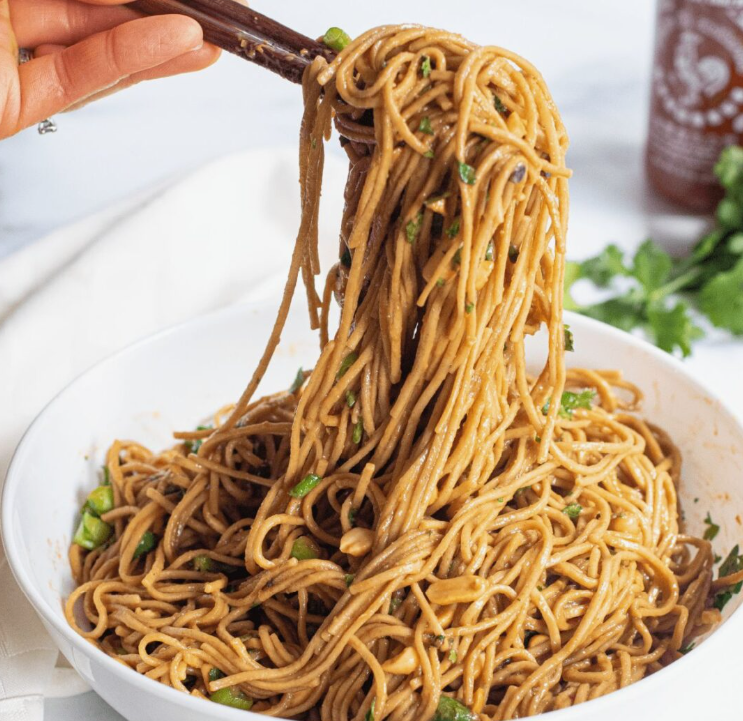
Introduction: Welcome to a culinary delight that perfectly balances taste and nutrition – Rice Noodles with Peanut Sauce and Veggies. This delectable dish is not only a feast for the taste buds but also a wholesome meal packed with essential nutrients. Whether you’re a seasoned chef or a novice in the kitchen, this recipe promises simplicity without compromising on flavor. Plus, with the added benefit of being SEO-friendly, you’re sure to attract food enthusiasts searching for a delightful Asian-inspired meal. Let’s dive into the ingredients and instructions to create this savory masterpiece.
Ingredients:
- Rice Noodles (200g)
- Mixed Veggies (bell peppers, carrots, broccoli, mushrooms) – 2 cups, sliced
- Peanut Butter (creamy) – ½ cup
- Soy Sauce – 3 tablespoons
- Sesame Oil – 2 tablespoons
- Garlic – 2 cloves, minced
- Ginger – 1-inch piece, grated
- Sriracha Sauce – 1 tablespoon (adjust to taste)
- Lime Juice – 2 tablespoons
- Brown Sugar – 2 tablespoons
- Crushed Peanuts – for garnish (optional)
- Green Onions – for garnish (optional)
- Sesame Seeds – for garnish (optional)
Instructions:
- Prepare Rice Noodles: Cook rice noodles according to package instructions until al dente. Once done, drain and rinse under cold water to prevent sticking. Set aside.
- Prepare Veggies: Heat sesame oil in a large pan over medium heat. Add minced garlic and grated ginger, sauté until fragrant. Then, add sliced veggies (bell peppers, carrots, broccoli, mushrooms) and cook until tender yet crisp, about 5-7 minutes. Remove from heat and set aside.
- Make Peanut Sauce: In a small saucepan, combine peanut butter, soy sauce, lime juice, brown sugar, and sriracha sauce. Cook over low heat, stirring continuously until well combined and smooth. If the sauce is too thick, you can add a splash of water to reach your desired consistency.
- Combine Noodles and Veggies: Once the peanut sauce is ready, pour it over the cooked rice noodles and toss until evenly coated. Add the sautéed veggies to the noodles and gently mix until everything is well combined.
- Serve: Transfer the rice noodles with peanut sauce and veggies to serving plates or bowls. Garnish with crushed peanuts, sliced green onions, and sesame seeds for an extra crunch and burst of flavor.
- Enjoy: Serve your delicious creation immediately and relish the fusion of flavors. This dish can be enjoyed hot or cold, making it perfect for any occasion.
With these simple steps, you’ve crafted a mouthwatering dish that’s sure to impress your family and friends. Get ready to indulge in the irresistible combination of savory peanut sauce, tender rice noodles, and vibrant veggies. Happy cooking!
Serving Tips:
- Garnish with Fresh Herbs: Before serving, sprinkle some freshly chopped cilantro or Thai basil over the dish to add a burst of freshness and aroma.
- Add Protein: For a heartier meal, consider adding some protein such as grilled tofu, shrimp, or chicken to the dish. This will not only enhance the flavor but also increase the nutritional value.
- Customize with Condiments: Set up a condiment station with additional sriracha sauce, chili flakes, or chopped peanuts, allowing your guests to customize their bowls according to their taste preferences.
- Pair with Refreshing Beverage: Serve the rice noodles with peanut sauce and veggies alongside a refreshing beverage like iced green tea or a fruity lemonade to complement the flavors and refresh the palate.
- Present with Style: Elevate the presentation by serving the dish in vibrant bowls or on decorative plates. A visually appealing presentation enhances the dining experience and makes the meal even more enjoyable.
Storage Tips:
- Refrigerate Properly: Store any leftovers in an airtight container and refrigerate promptly. Rice noodles with peanut sauce and veggies can typically last for up to 3-4 days when properly stored in the refrigerator.
- Separate Sauce and Noodles: If storing leftovers, consider separating the noodles and sauce to prevent the noodles from becoming soggy. Store the sauce in a separate container and mix it with the noodles when reheating.
- Avoid Freezing: While the noodles and veggies can be refrigerated, it’s best to avoid freezing as the texture may become mushy upon thawing. Freshly prepared rice noodles with peanut sauce and veggies are best enjoyed when freshly made.
- Reheat with Care: When reheating, gently heat the noodles and sauce in a pan over low heat or in the microwave, stirring occasionally to ensure even heating. Add a splash of water if the sauce has thickened too much.
- Enjoy Fresh Additions: If you plan to enjoy the dish over multiple days, consider keeping some fresh garnishes like chopped peanuts, green onions, and lime wedges on hand to add a burst of flavor and texture to each serving.
By following these serving and storage tips, you can ensure that your rice noodles with peanut sauce and veggies remain fresh, flavorful, and enjoyable for every meal.
Variations:
- Thai-Inspired Variation: For a Thai-inspired twist, swap out the soy sauce in the peanut sauce for fish sauce, and add a tablespoon of Thai red curry paste for an extra kick of flavor. Garnish with chopped cilantro and a squeeze of fresh lime juice before serving.
- Spicy Peanut Variation: If you love heat, increase the amount of sriracha sauce in the peanut sauce or add a diced red chili pepper for an extra spicy kick. You can also stir in some chili oil or chili flakes for added heat.
- Protein-Packed Variation: Boost the protein content of the dish by adding cooked edamame, grilled tofu, shredded rotisserie chicken, or sautéed shrimp. Simply toss the protein of your choice with the noodles and veggies before coating them with the peanut sauce.
- Nut-Free Variation: For those with nut allergies, replace the peanut butter with sunflower seed butter or tahini (sesame seed paste) in the sauce. Adjust the seasoning accordingly and enjoy the same creamy texture and nutty flavor without the risk of allergens.
- Crunchy Variation: Add an extra layer of texture by incorporating crispy elements like sliced water chestnuts, bean sprouts, or toasted sesame seeds into the dish. These crunchy additions will complement the soft noodles and veggies beautifully.
- Soba Noodles Variation: Switch up the type of noodles by using soba (buckwheat) noodles instead of rice noodles. Soba noodles have a nutty flavor and chewy texture that pairs wonderfully with the peanut sauce and veggies.
- Coconut Peanut Variation: Create a tropical twist by adding a splash of coconut milk to the peanut sauce. The creamy coconut flavor pairs harmoniously with the nuttiness of the peanut sauce, creating a rich and indulgent dish.
- Curry Peanut Variation: Infuse the dish with aromatic curry flavors by stirring in a tablespoon of curry powder or curry paste into the peanut sauce. This variation adds depth and complexity to the dish, making it a flavorful culinary adventure.
- Sesame Ginger Variation: Enhance the Asian-inspired flavors by adding toasted sesame oil and grated ginger to the peanut sauce. The combination of nutty sesame and spicy ginger adds a delightful zing to the dish, tantalizing the taste buds with every bite.
- Cold Noodle Salad Variation: Transform the dish into a refreshing cold noodle salad by chilling the cooked noodles and veggies before tossing them with the peanut sauce. Serve chilled with a sprinkle of chopped peanuts and a squeeze of lime juice for a refreshing and satisfying meal on a hot day.
These variations offer endless possibilities for customizing the dish to suit your taste preferences and dietary needs, ensuring that every bite is a delightful culinary experience. Experiment with different ingredients and flavors to create your own signature version of rice noodles with peanut sauce and veggies.
FAQs (Frequently Asked Questions):
- Can I use other types of noodles for this recipe? Yes, you can use various types of noodles such as wheat noodles, soba noodles, or even spiralized vegetables like zucchini or carrots for a healthier alternative. Adjust cooking times accordingly based on the type of noodles or vegetables you choose.
- Is this recipe suitable for vegetarians and vegans? Yes, this recipe is vegetarian-friendly as it does not contain any meat or animal products. To make it vegan-friendly, ensure that the peanut butter used is free from any added dairy ingredients. Additionally, check the ingredients of the soy sauce to ensure it’s vegan-friendly or use a substitute like tamari.
- Can I make this recipe gluten-free? Absolutely! Simply use gluten-free soy sauce or tamari instead of regular soy sauce, and ensure that the other ingredients, including the rice noodles and peanut butter, are certified gluten-free. This adjustment allows individuals with gluten sensitivities or celiac disease to enjoy the dish safely.
- How can I make this dish less spicy? If you prefer a milder version of the dish, simply reduce or omit the sriracha sauce and adjust the amount of fresh chili pepper according to your spice tolerance. You can also serve additional condiments like yogurt or sour cream on the side to help balance the heat.
- Can I prepare this dish ahead of time for meal prep? Yes, you can prepare the components of this dish ahead of time for meal prep. Cook the noodles and veggies separately, and store them in airtight containers in the refrigerator. Make the peanut sauce and store it in a separate container. When ready to eat, simply reheat the noodles and veggies, then toss them with the peanut sauce.
- How do I store leftovers? Store any leftovers in an airtight container in the refrigerator for up to 3-4 days. It’s best to store the noodles and sauce separately to maintain their texture. Reheat gently on the stove or in the microwave, adding a splash of water to the sauce if needed to loosen it up.
- Can I freeze this dish? While it’s possible to freeze the components of this dish, it’s not recommended as the texture of the noodles and veggies may become mushy upon thawing. Freshly prepared rice noodles with peanut sauce and veggies are best enjoyed when freshly made.
- How can I adjust the recipe for a larger or smaller serving size? To adjust the recipe for a larger or smaller serving size, simply scale the ingredients accordingly. Keep in mind the ratio of noodles to sauce and veggies, and adjust the seasoning to taste. It’s always better to start with less seasoning and adjust as needed to avoid over-seasoning the dish.
Conclusion:
In conclusion, Rice Noodles with Peanut Sauce and Veggies is a versatile and flavorful dish that offers a delightful fusion of Asian-inspired flavors. Whether you’re cooking for a weeknight dinner or entertaining guests, this recipe promises to satisfy both your palate and your appetite. From the creamy peanut sauce to the vibrant array of vegetables, every bite is a symphony of taste and texture.
With its simple preparation and customizable nature, this dish lends itself well to various dietary preferences and culinary experiments. Whether you’re looking to add extra protein, spice things up with different variations, or adapt the recipe to suit specific dietary needs, there’s endless room for creativity.
